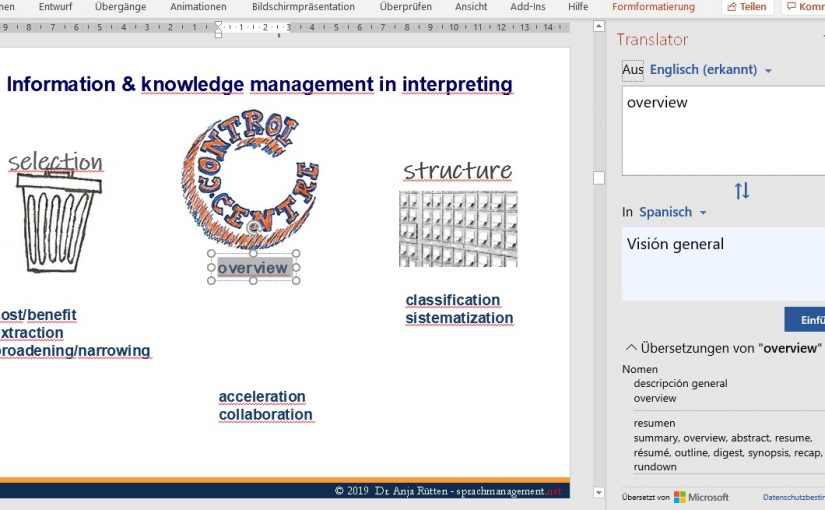When it comes to Computer-Aided Interpreting (CAI), a question widely discussed in the interpreting community is whether information being provided automatically by a computer in the booth could be helpful for simultaneous interpreters or if would rather be a distraction. Or to put it differently: Would the cognitive load of simultaneous interpreting be increased by the additional input, or would it be decreased by providing helpful information that the interpreters would otherwise have to retrieve from their longterm memory.
Of course, interpreting is not about translating single words, but about ideas being understood in one language and then expressed in another. But on the other hand, we all (conference interpreters or not) know the occasional tip of the tongue, when we just can’t think of the German word for, say, nitric acid, and might appreciate a little trigger to remember a particular word or expression.
One scenario of CAI often discussed is that the source speech is analysed by a speech recognition software, critical terminology is extracted and, based on the interpreter’s glossary, a dictionary or other sources, the equivalent in the target language is displayed on the screen. This technology still has many limitations, especially the speed and quality/reliability of the speech recognition function. But while we are waiting for this solution to become market-ready, I have recently come to like a tool which is altogether quite different in its original aim but can be used for a similar purpose: The Microsoft Translator.
In Powerpoint, for example, by just clicking on a text element the translator window opens next to the slide, and remains open. It translates complete texts or single words, and it has turned out to be quite useful for me in some situations, especially when interpreting presentations based on Powerpoint files I had not had the time to read before the meeting.
But would I say that the Microsoft Translator is a tool I consider a valuable support in the booth? The answer clearly is: it depends.
Quality varies considerably between language pairs. While English-Spanish seems to be one of the well-developed “premium” combinations with sometimes impressive results, French-German did not really convince me.
You can never rely on the system to understand the message. And running a mental plausibility check in parallel to the normal interpreting job plus reading the translation on the screen is not an option.
But: If you manage to use the translator simply to prompt your brain when you are searching for a particular word, preferably one that leaves no room for mistranslations (like sodium, elderflower or forklift truck), it may make your life easier.
The nice thing is that this translator, which can also be used as a dictionary, runs within Powerpoint, so you can read your presentation and pre-translate texts very easily. It does not involve any typing or skipping between different windows.
After all, we are still at the beginning of what CAI brings. The Microsoft Translator is an easily accessible tools nice enough to play around with and get a flavour of what language technology brings for conference interpreters. And I am really curious to hear what your experience is!
About the author
Anja Rütten is a freelance conference interpreter for German (A), Spanish (B), English (C) and French (C) based in Düsseldorf, Germany. She has specialised in knowledge management since the mid-1990s.


Leave a Reply